Meridians (Jing Luo)
Primary Meridians | Extra-Ordinary Meridians
In TCM theory, the body is crisscrossed by a network of channels where Qi (the vital energy of the body) and other material/immaterial substances flow through. These myriad pathways are collectively known as meridians (Jing Luo). When Qi flows freely through the meridians, the body is balanced and healthy, but if Qi becomes blocked, stagnated or weakened, it can result in physical, mental or emotional ill health. TCM procedures such as acupuncture, Tai Chi and Qi Gong achieve their effects by manipulating and balancing of Qi running through meridians.
The meridians connect upper and lower parts of the body, internal and external aspects, and the organs and tissues. Together, they integrate various parts of the body into an organic whole and provide a network of communication, transportation, assistance, and regulation that keeps our systems running smoothly.
Primary Meridians
The twelve Primary Meridians are related to and named after the twelve Zang Fu organs. Each organ, with its own physiological and invisible energy functions, is not only dependent on the other organ systems but also on the greater meridian network. Acupuncture points are located on the twelve Primary Meridians; acupuncture and acupressure correct imbalances in the organ systems by manipulating Qi in the related meridians. The twelve Primary Meridians run on each side of the body, one side mirroring the other.
Twelve Primary Meridians:
| Extremity | Yin / Yang | Meridian | |
| Arm | Yin | Greater Yin (Tai Yin) | Lung (Lu) |
| Lesser Yin (Shao Yin) | Heart (Ht) | ||
| Absolute Yin (Jue Yin) | Pericardium (Pc) | ||
| Yang | Brightness Yang (Yang Ming) | Large Intestine (Li) | |
| Greater Yang (Tai Yang) | Small Intestine (Si) | ||
| Lesser Yang (Shao Yang) | San Jiao (SJ) | ||
| Leg | Yin | Greater Yin (Tai Yin) | Spleen (Sp) |
| Lesser Yin (Shao Yin) | Kidney (Ki) | ||
| Absolute Yin (Jue Yin) | Liver (Lv) | ||
| Yang | Brightness Yang (Yang Ming) | Stomach (St) | |
| Greater Yang (Tai Yang) | Urinary Bladder (Ub) | ||
| Lesser Yang (Shao Yang) | Gallbladder (Gb) | ||
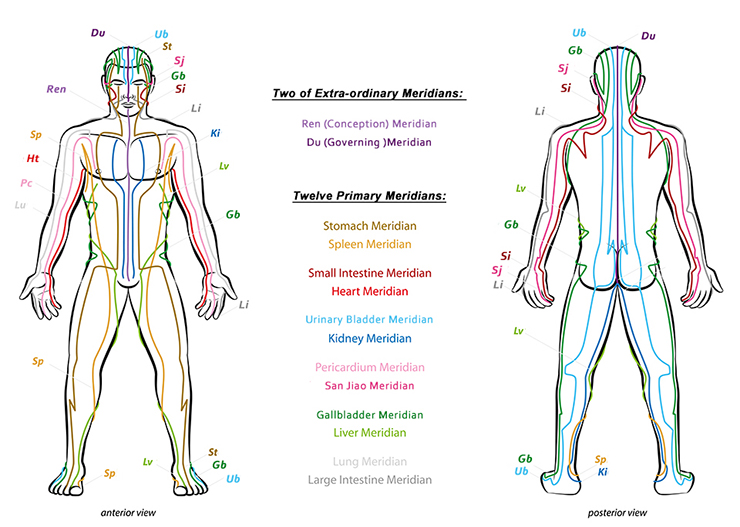
Extra-ordinary Meridians
In addition to twelve Primary Meridians, there are eight Extra-ordinary Meridians: Du, Ren, Chong, Dai, Yin Qiao, Yang Qiao, Yin Wei, and Yang Wei. The primary function of eight Extra-ordinary Meridians is strengthening the links between the twelve Primary Meridians and regulating the flow of Qi and Blood. They have special relationships with the Liver, the Kidney, the Uterus, the Brain and the Marrow; they influence these organs physiologically and pathologically. Of the eight Extra-ordinary Meridians, only Du and Ren have acupuncture points of their own, running up the midline of the back and front of the torso, respectively.
Du (Governing vessel)
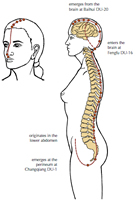

It is called “Sea of Yang meridians” since this meridian meets all the Yang meridians (Large intestine, Stomach, Small intestine, Urinary bladder, San Jiao and Gallbladder). It governs Qi of all Yang meridians and maintains warming and transforming functions of organs. Du meridian plays an important role in our capacity of thinking and memory, as well as independence and determination by providing the force behind self-growth and self-development. Du meridian has close relationships with the Brain, spinal cord, Kidney and genital area. It nourishes the Brain and spinal cord, strengthens the back and tonifies Kidney Yang. It also makes the blood exit the body during menstruation in women and powers erection and ejaculation in men.Image from Manual of Acupuncture
Ren (Conception vessel)
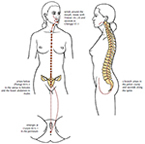
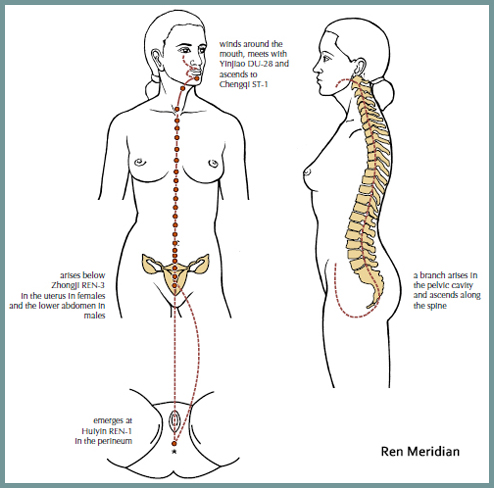
This meridian is called “Sea of Yin” since it meets all Yin meridians (Lung, Spleen, Heart, Kidney, Pericardium and Liver). It governs Qi of Yin meridians. It provides Yin substances (Essence, Blood and Body fluids) for all physiological activities. Ren meridian affects the abdomen, thorax, throat, lungs and face. In women, this meridian is thought to originate in the Uterus where the fetus is nourished, thus it influences menstruation, fertility, conception, pregnancy, childbirth and menopause. In men, this meridian nets with the genitals and supports sexual, reproductive, and urinary functions.Image from Manual of Acupuncture
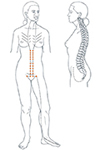
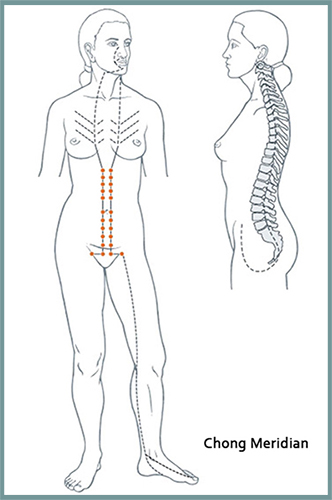
Chong (Penetrating vessel)
It is regarded as “Sea of Blood”, which is the place for the twelve Primary Meridians to converge and where it helps regulate the Qi and Blood inside them. This meridian regulates the Uterus for menstruation, fertility, conception, pregnancy, childbirth and menopause in women and rebalance the reproductive system for erection, emission and ejaculation in men.
Image from Manual of Acupuncture
Dai (Girdling vessel)

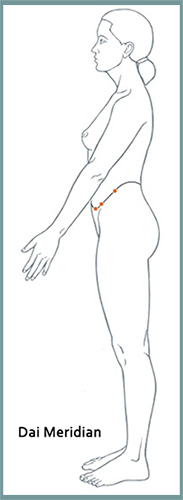
Dai meridian is the only meridian that flows horizontally. Originated from the lateral ribs, it descends to the waistline and encircles the waist like a belt. This meridian binds up all meridians of the leg that run vertically on the truck, promoting their interconnected relationship and keeping the organs in place. Dai meridian divides the body into two halves and keeps effective energy flow between those two halves. In women, it also takes charge of nourishing and lubricating the Uterus and controls menstruation and vaginal discharge as it passes through the Uterus like a girdle. Dai meridian is the reservoir of all traumas (physical and emotional) and can hold the emotions we can’t deal with. It is our self preservation; it can create stability during changes and play a powerful role in survival. Image from Manual of Acupuncture
Yang Qiao (Yang Heel vessel) and Yin Qiao (Yin Heel vessel)
Yang Qiao and Yin Qiao originate on the outside/inside of the heel. Since they connect with all Yin meridians and Yang meridians respectively, they have an important role in regulating Yin and Yang throughout the body. They dominate activity and rest of the body.
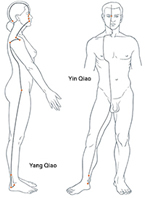
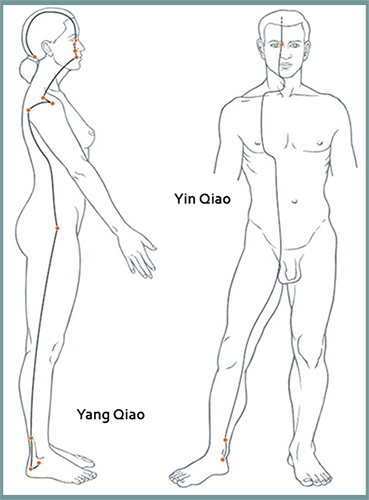
Yang Qiao governs body movements during the day, balance gait or instability. This meridian connects to our extroverted side and influences how we stand up to the world. It helps us respond to external stimuli and helps those who are in constant rebellion against the world or who are high very judgemental.
Yin Qiao regulates Qi and Blood flow from the heel to the eyes. It is in charge of sleep at night and the closure of the eyes. This meridian connects to our introverted side and influences how we stand up to ourselves. It allows us to look neutrally at our thoughts, feelings, emotions, and actions. It also supports healthy relationship to our bodies to prevent distorted body image and help us connect to our sexual identity. Image from Manual of Acupuncture
Yang Wei (Yang Linking vessel) and Yin Wei (Yin Linking vessel)
Yang Wei and Yin Wei function as connecting or networking vessels. They are related to the transitions involved in the aging process, as they help maintain the balance of Yin and Yang of the body
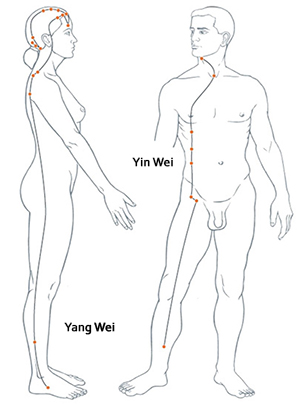

Yang Wei strengthens the connection between all Yang meridians and governs the exterior of the body. It represents the last stage of defense before the body is penetrated by an invading pathogen. Yang Wei regulates old habits and patterns. It also supports our strength needed for transformation, helps us move forward in life, prevents self-sabotage in relationships.
Yin Wei supports Qi and Blood in all Yin meridians and governs the interior of the body. This meridian helps us to respond to life with clarity and compassion; it helps us to rise above feeling of inadequacy or failures, and processes transitions in life and rites of passage. It can be used for being trapped in past emotions (not letting go), not being in the moment or difficulty with self-image associated with aging. Image from Manual of Acupuncture
NOTE: The names of organs are capitalized when referring to the entire, functional organ systems in TCM perspective: Liver, Blood, etc. The names of organs are lower-cased when referring to the distinct, biomedical organs: liver, blood, etc.